Giant bamboo, Sweet bamboo
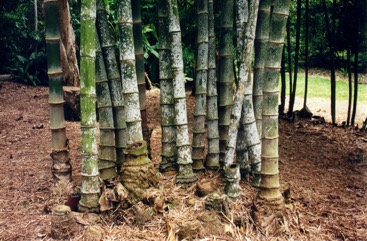
A tropical bamboo. In tropical Asia it grows from sea level to 1500 m altitude. It does best between 400-500 m altitude. It grows best on heavy soils with good drainage. It is found in Makiling Forest in Laguna in the Philippines at lower elevations and also in Mindanao.In the Cairns Botanical Gardens. In XTBG Yunnan. It suits hardiness zones 9-12.
Also known as:
Au betun, Awi bitung, Bambu betung, Bambu cetong, Betung, Bitoong Bamboo, Bukawe, Buloh Betong, Buloh panching, Buluh batung, Deling petung, Hok, Jajang betung, Kuur, Kyalu-wa, Manh tong, Petunu, Phai-tong, Pring betung, Soon, Sun, Tre manh tong, Zhu Sun
Synonyms
- Bambusa aspera Schult. & Schult. f.
- Dendrocalamus flagellifer Munro
- Dendrocalamus merrillianus (Elmer) Elmer
- Gigantochloa aspera (Schult. & Schult. f.) Kurz
Edible Portion
- Shoots
Where does Giant bamboo grow?
Found in: Africa, Asia, Australia, Benin, Central Africa, China, Congo, East Africa, East Timor, Ghana, India, Indochina, Indonesia, Kenya, Laos, Madagascar, Malaysia, Myanmar, Pacific, Papua New Guinea, PNG, Philippines, SE Asia, Singapore, Taiwan, Thailand, Timor-Leste, United States, Vietnam, West Africa
Notes: There are about 29 Dendrocalamus species. Most bamboo shoots contain hydrogen cyanide which is destroyed on cooking.
Status: It is a cultivated food plant.
Growing Giant bamboo, Sweet bamboo
Cultivation: It can be grown from rhizomes, culm or branch cuttings. The spacing is 5-10 m apart. Mulching is essential to produce young shoots.
Edible Uses: The tender shoots are eaten as a vegetable or pickled in vinegar or salted. The shoots are harvested before they emerge from the soil. The shoots have good canning quality.
Production: The shoots emerge in the rainy season. They develop to their full height in one year. A good healthy clump can produce several shoots each year. A good clump with 10 culms can produce 60 shoots in one year. The edible portion of young shoots is 5.4 kg before peeling and 1.8 kg after peeling. A well established plantation can produce 10 tonnes/ha/yr or edible shoots.
Nutrition Info
per 100g edible portion| Edible Part | Energy (kcal) | Protein (g) | Iron (mg) | Vitamin A (ug) | Vitamin c (mg) | Zinc (mg) | % Water |
|---|---|---|---|---|---|---|---|
| Shoots | 17 | 2.5 | - | - | - | - |
Giant bamboo, Sweet bamboo Photos

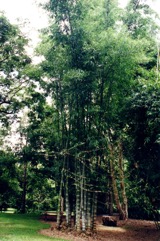
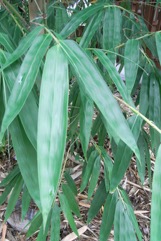
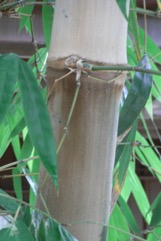
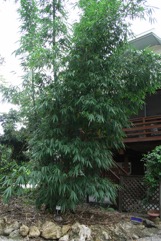
References
Arora, R. K., 2014, Diversity in Underutilized Plant Species - An Asia-Pacific Perspective. Bioversity International. p 40
Borrell, O.W., 1989, An Annotated Checklist of the Flora of Kairiru Island, New Guinea. Marcellin College, Victoria Australia. p 23
Brink, M., 2008. Dendrocalamus asper (Schult. & Schult.f.) Backer ex K.Heyne. [Internet] Record from Protabase. Louppe, D., Oteng-Amoako, A.A. & Brink, M. (Editors). PROTA (Plant Resources of Tropical Africa), Wageningen, Netherlands. < http://database.prota.org/search.htm>. Accessed 15 October 2009.
Burkill, I.H., 1966, A Dictionary of the Economic Products of the Malay Peninsula. Ministry of Agriculture and Cooperatives, Kuala Lumpur, Malaysia. Vol 1 (A-H) p 792
Cundall, P., (ed.), 2004, Gardening Australia: flora: the gardener's bible. ABC Books. p 487
Dransfield, S. & Widjaja, EA., 1995, Plant Resources of South East Asia. PROSEA No. 7 Bamboos. Leiden. p 21, 80
Facciola, S., 1998, Cornucopia 2: a Source Book of Edible Plants. Kampong Publications, p 46
Foo, J.T.S.(ed), 1996, A Guide to Common Vegetables. Singapore Science Foundation. p 18
Friday, J. B., 2005, Forestry and Agroforestry Trees of East Timor. http://www.ctahr.hawaii.edu/forestry/data/Timor/Timor trees.html
Hibbert, M., 2002, The Aussie Plant Finder 2002, Florilegium. p 84
http://www.plantnames.unimelb.edu.au/sorting/Bamboos_Edible.html
http://www.plantnames.unimelb.edu.au/sorting/Bamboos_Edible.html (As Sinocalamus flagellifer)
Hu, Shiu-ying, 2005, Food Plants of China. The Chinese University Press. p 287
Indian Forester 1:340. 1875 (As Gigantochloa aspera)
Martin, F.W. & Ruberte, R.M., 1979, Edible Leaves of the Tropics. Antillian College Press, Mayaguez, Puerto Rico. p 194
Monsalud, M.R., Tongacan, A.L., Lopez, F.R., & Lagrimas, M.Q., 1966, Edible Wild Plants in Philippine Forests. Philippine Journal of Science. p 475 (As Gigantochloa aspera)
Nutt. pl. Ned.-Ind. ed. 2, 1:301. 1927
Ochse, J.J. et al, 1931, Vegetables of the Dutch East Indies. Asher reprint. p 307
Ong, H., et al, 2012, Traditional knowledge and usage of edible plants among the Semai community of Kampung Batu 16, Tapah, Perak, Malaysia. Scientific Research and Essays Vol. 7(4), pp. 441-445, 30 January, 2012
Peekel, P.G., 1984, (Translation E.E.Henty), Flora of the Bismarck Archipelago for Naturalists, Division of Botany, Lae, PNG. p 56
Solomon, C., 2001, Encyclopedia of Asian Food. New Holland. p 17
Sukarya, D. G., (Ed.) 2013, 3,500 Plant Species of the Botanic Gardens of Indonesia. LIPI p 839
Tanaka, Y & Van Ke, N., 2007, Edible Wild Plants of Vietnam. Orchid Press. p 119
USDA, ARS, National Genetic Resources Program. Germplasm Resources Information Network - (GRIN). [Online Database] National Germplasm Resources Laboratory, Beltsville, Maryland. Available: www.ars-grin.gov/cgi-bin/npgs/html/econ.pl (10 April 2000)
van Wyk, B., 2005, Food Plants of the World. An illustrated guide. Timber press. p 174
World Checklist of Useful Plant Species 2020. Royal Botanic Gardens, Kew
Yang, Y., et al, A review of bamboo resources in Yunnan, China www.bioversityinternational.org